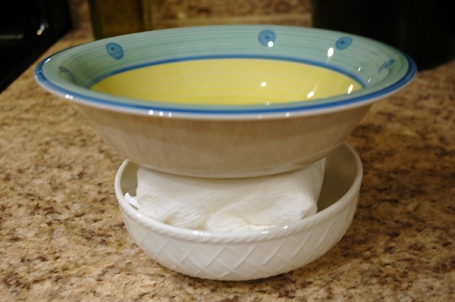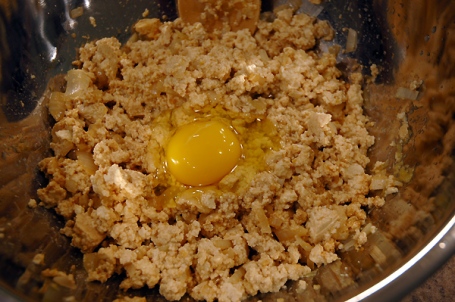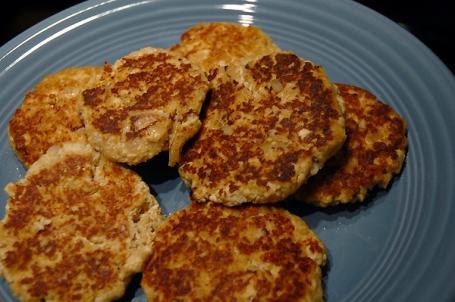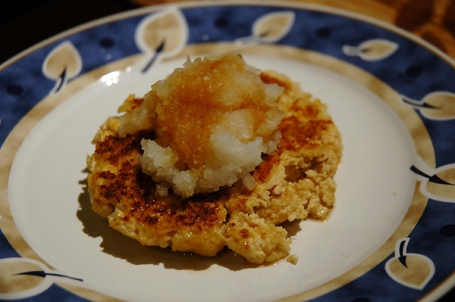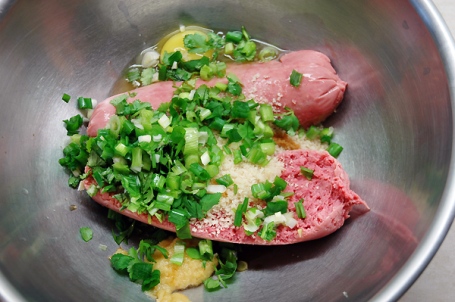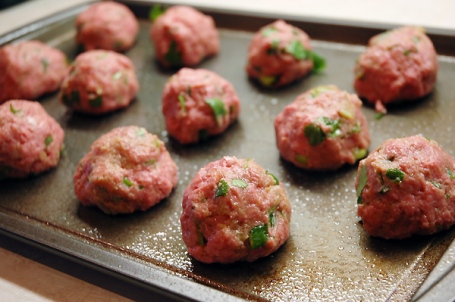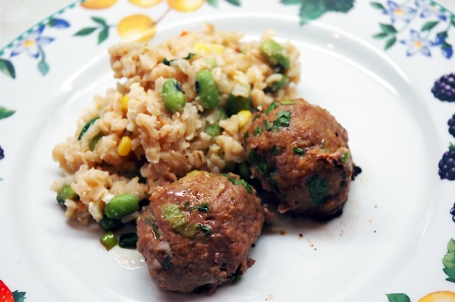Posts filed under ‘Japanese food’
Okonomiyaki (Japanese savory meat and vegetable pancake) お好み焼き
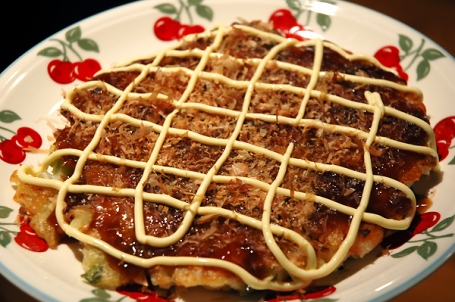
Have you ever had Japanese okonomiyaki? It’s a very common food in Japan.
The name basically means “grilled as you like it” “what you want grilled”, and it’s basically a savory pancake of sorts. The batter and toppings vary according to region, but it’s basically a batter of flour and water or broth with finely shredded cabbage, green onions, and whatever meat or seafood you want in it. There’s a lot of variations, but that’s it in it’s most basic form.
On top of the finished okonomiyaki is usually a layer of okonomiyaki sauce (available in most Asian markets), a sauce similar to Worcestershire sauce, but thicker and sweeter, aonori (finely crushed seaweed flakes), katsuobushi (bonito fish flakes), and Japanese mayonnaise.
If you’re unfamiliar with Japanese cuisine, you may be thinking, “Seaweed flakes? Fish flakes? The heck?!” But the seaweed flakes have great flavor. To get bonito flakes, the beheaded, gutted, and filleted fish is simmered, smoked, and then dried. It becomes hard which makes it easy to cut very thin flakes off of it. They have the flavor of smoked fish. Very tasty. Trust me.
Also, if you want to be really authentic, get Japanese mayonnaise for this. You can find it at most Asian markets. The most famous brand of Japanese mayonnaise is “Kewpie Mayonnaise”. Japanese mayonnaise tastes different than American mayonnaise, so if you’re feeling adventurous, want your okonomiyaki to be really authentic, or you’re like my husband and think American mayonnaise tastes icky, get ya some Kewpie mayonnaise.
For this recipe I made a pretty standard okonomiyaki with shrimp in it. Unfortunately, I was out of aonori (that’s why there’s no green on top of my finished okonomiyaki), but I’ve included it in the recipe.
This makes two large okonomiyaki (probably enough for 3 – 4 people), so feel free to adjust the amounts for the number of people you’re cooking for.
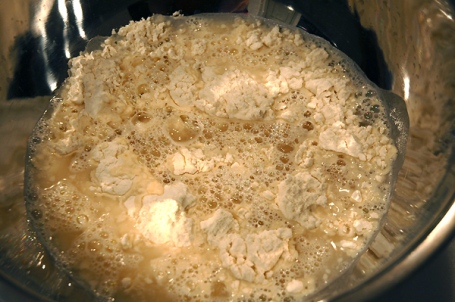
First mix 1 1/2 cups of flour and 1 1/2 cups of dashi (Japanese broth – you can find them in powdered form in most Asian grocery stores) or water. Mix it all up until you have a nice, lump-free batter.
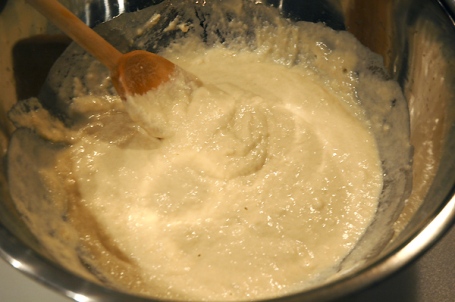
Like so. It should be about the consistency of pancake batter. If it’s too thick or too thin, feel free to add more flour or water as necessary.
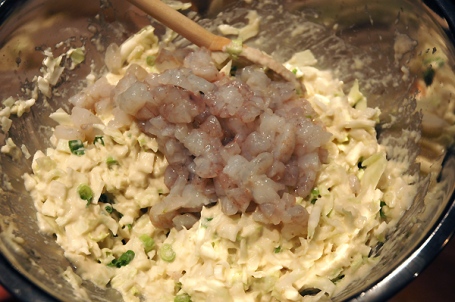
Add 3 cups of diced cabbage, 3 or 4 diced green onions, and about 1 1/2 – 2 cups diced raw shrimp (peeled and de-veined), and mix.
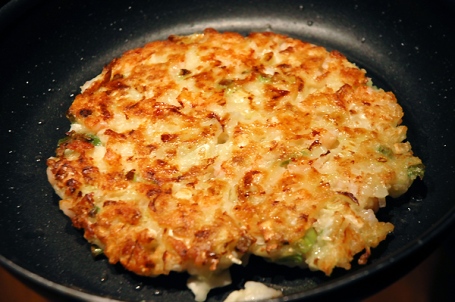
Heat a couple of tablespoons of olive oil in a large skillet over medium high heat, and spoon half the batter onto it. Use a spoon to smoosh it out into a circular shape about 1/2 – 3/4 and inch in thickness. Cook the okonomiyaki until it’s golden brown on one side, then (very carefully) use two large spatulas to flip it over and cook it on the other side until it’s golden brown. Repeat with the remaining batter.
Hint: If you don’t think you can flip it, and it is a bit tricky, use a spatula to cut it in half, then flip each half over.
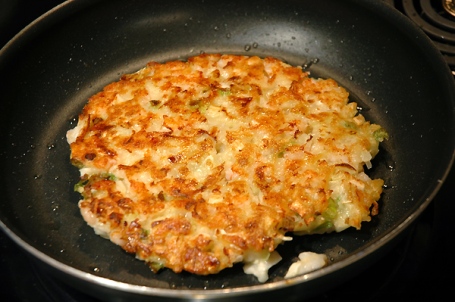
If you want to give it a little extra something, add a little sesame oil along with the olive oil when you cook it. If you’ve never had it, sesame oil has fabulous flavor and aroma. Don’t use nothing but sesame oil though, as its flavor would overpowering the okonomiyaki, and sesame oil doesn’t handle high temperatures well.

Remove the finished okonomiyaki to a plate, drizzle some okonomiyaki sauce on it, spread it into an even layer with a spoon, sprinkle some aonori and katsuobushi (the bonito fish flakes) over it (if you want of course), and then drizzle some mayonnaise on top (again, optional), and dig in.
Okonomiyaki
(makes two large pancakes, enough for 3 – 4 people)
- 1 1/2 c. unbleached all-purpose flour
- 1 1/2 c. dashi broth or water
- dash of salt
- 3 c. diced cabbage
- 3 – 4 green onions, diced
- 1 1/2 – 2 c. diced raw shrimp (peeled and de-veined)
- 2 Tbsp. extra virgin olive oil (plus one tsp. sesame oil – optional)
- okonomiyaki sauce
- aonori (seaweed flakes) (optional)
- katsuobushi (bonito flakes) (optional)
- Mayonnaise (optional)
- In a large bowl, mix the flour, a dash of salt, and dashi together until smooth. Add the cabbage, onions, and shrimp, and mix until well combined.
- Heat oil in a large skillet over medium-high heat. Spoon half the batter into the skillet and use a spatula to form it into a circular shape about 1/2 – 3/4 inch thick. Cook on one side until golden brown, then use two spatulas to flip it over, and cook on the remaining side until golden brown. Remove to a plate, and repeat with the remaining batter.
- To serve, drizzle okonomiyaki sauce over the finished pancake, then spread it around evenly with a spoon. Sprinkle aonori and katsuobushi over it, and then top it off with mayonnaise drizzled over the top (if using).
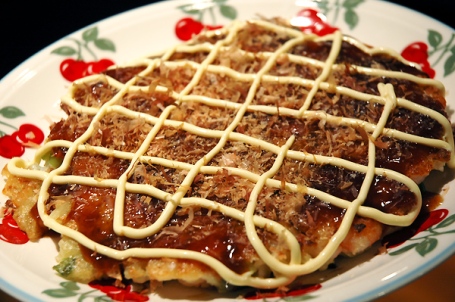
Japanese Tofu Hamburger Steak (豆腐ハンバーグ)
If there’s one thing I love, it’s Japanese tofu hamburger steaks (called “tofu hanbahgu” or tofu hamburg).
Heck, there’s a lot of things I love from Japanese cuisine. Teriyaki salmon, inari sushi, sushi in general, grilled eel, curry rice, korokke, tempura, chestnut rice, kabocha… I could go on and on, but I’d probably start to drool. And then I would probably drive to the other end of Houston to the Japanese grocery store, buy half the store, rush home, and spend the rest of the day creating an elaborate over the top feast with enough food for 10 people… for my husband and I. So, I shall desist…
The best way to eat tofu hamburger steaks, in my opinion, is with daikon oroshi (simply, grated Japanese radish) and ponzu (a citrus-infused soy sauce condiment). If you’ve never seen a Japanese radish, they look like this…
They’re generally about a foot long, but their size and shape can vary immensely. You can find daikon at most Asian supermarkets. To make grated daikon, wash your daikon, peel off the outside layer like a carrot, and then….grate it….with a grater. Easy right? Just kidding. You don’t want strips of grated daikon like grated cheese, you want a finely minced daikon mush. Sounds yummy, right? Trust me, it is.
I use my Microplane zester, which works great, but you could even throw some daikon in your food processor and whiz it to a pulp (literally).
Once you’ve successfully grated as much daikon as you think you’ll need, drain off some of the excess liquid, and you’re done.
If you can’t find Japanese daikon, or you don’t want to be bothered to go to an Asian supermarket (or if you don’t have an Asian supermarket), you can use regular ol’ American radishes. Just be very careful when grating/zesting them, as they’re so small, you run a much larger risk of accidentally zesting your fingertips (yes, it can be done). Not a pretty picture. Exercise caution.
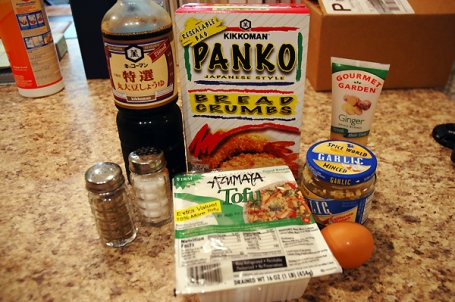
OK! First things first! Here’s the ingredients you need: 1 block of firm tofu, 1/2 onion (which I forgot to put in the picture; he’s anti-social), minced garlic, extra virgin olive oil (also anti-social), ginger paste, an egg, salt and pepper, and panko bread crumbs.
Mince the onion as finely as you can (you can even whiz it in the food processor to a pulp; that seems to be a theme today…), and saute it in a skillet over medium heat with the olive oil. After 2 – 3 minutes, add the garlic and continue sauteing until the onion is translucent, another 2 minutes or so.
Meanwhile, swaddle wrap your tofu block in paper towels, place it on a plate or in a bowl, and place another, heavy dish on top, like so. Microwave it all for 3 – 4 minutes. This will help get rid of the excess water in the tofu.
Carefully unwrap the tofu, as it will be very hot by this point, and add it to a large bowl. Add the cooked onion and garlic, the ginger paste, the soy sauce, and a light dash of salt and pepper. Mix everything, crumbling up the tofu as much as possible. The best way to do this is with your hands. Go on. Get in their and get dirty! Just make sure you wash your hands before and after the tofu mushing. And make sure the tofu is sufficiently cooled, so you don’t burn your hands in your eagerness to smoosh it.
Once everything is well mixed, and the tofu is well smooshed and crumbly, add the egg, and mix it in. Then, add the bread crumbs, and mix it yet again. A spoon works fine for these last two additions.
Now, at this point, you can either cover and refrigerate the mixture for an hour; form it into patties, place those on a baking sheet, cover and refrigerate that for an hour; or form it into patties and and cook them immediately. I recommend one of the first two methods. By refrigerating it for an hour or more, it really allows the flavors to be absorbed into the tofu and will taste better as a result. If you’re in a hurry though, by all means, go for it!
Once you’re ready to cook the patties, add a little olive oil to a skillet over medium-high heat. Form the mixture into patties (if you haven’t already), and cook them, about four at a time, until browned on one side. Flip them, and continue cooking until they’re golden brown on that side as well. Remove the patties to a serving plate, and repeat with the remaining patties.
After cooking, they should look something like this.
To eat, spoon some of that delicious daikon oroshi you worked hard to get on top of a patty, then pour a little ponzu over the top (not too much, as it’s strong stuff). Then, enjoy.
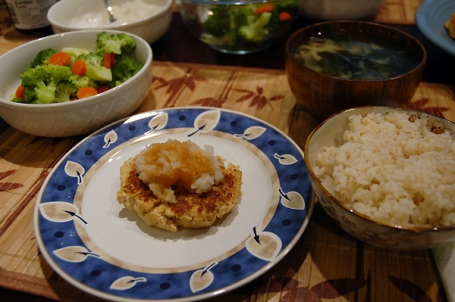
Serve with Japanese steamed rice, miso soup, and any other Japanese side dishes you want.
Japanese Tofu Hamburger Steaks
(makes about 10 patties)
- 1 (16 oz.) block of firm tofu
- 1/2 onion, finely diced
- 3 cloves minced garlic
- 1 Tbsp. extra virgin olive oil, plus more for cooking the patties
- 1 Tbsp. ginger paste
- 2 1/2 Tbsp. soy sauce
- light dash of salt and pepper
- 1 egg
- 1/2 c. panko bread crumbs
- 3/4 – 1 c. grated Japanese daikon (optional)
- Ponzu (optional)
- Heat olive oil in a skillet over medium heat. Cook the onion for 2 – 3 minutes. Add the garlic and cook for another 2 – 3 minutes. Remove from heat.
- Wrap tofu in paper towels and place on a plate. Place a heavier dish on top of the tofu, and microwave it all for 3 – 4 minutes.
- Carefully unwrap tofu and add it to a large bowl. Add the cooked onion and garlic, ginger paste, soy sauce, and a light dash of salt and pepper. Mix everything well with a large spoon or your hands. Add the egg and mix again, then add the bread crumbs and mix again. Cover the bowl and refrigerate it for one hour.
- Heat 1 – 2 Tbsp. of olive oil in a large skillet over med-high heat. Form the mixture into patties and cook, about four at a time, until browned on one side. Flip the patties cook on the remaining side until well browned. Remove to a serving plate, and repeat with the remaining patties.
- Serve with grated daikon and ponzu.
Asian Turkey Meatballs with Lime Sesame Sauce
Last Saturday morning I got the closest I’ve ever come to passing out.
It was the weirdest thing. I woke up first, and as my mom usually fixes breakfast on Saturday morning, I relaxed, read for awhile, set the table, etc. By the time we finally ended up eating breakfast (almost an hour and a half after I’d gotten up), I was starving.
It was a wonderful breakfast (cinnamon and raisin scones, turkey sausage, and scrambled eggs), and even after we were done eating, we continued talking for awhile.
About 5 minutes after I finished eating, and while we were talking, I started feeling slightly nauseous. Not only that, but it’s like my body was going numb and getting increasingly heavy at the same time. Finally, it was like someone turned my brain off. I was looking at my mom as she was talking, but it was like she was fading into the distance. I could actually hear her voice receding. I realized I was probably going to either pass out or vomit, so I quickly excused myself to the bathroom, where I promptly sat down, stuck my head between my knees, and concentrated on taking slow, deep breaths. That seemed to do the trick, because my naseau gradually faded and the world faded back in.
When I was sure I was no longer going to vomit or pass out, I headed back to the kitchen table, sat down, and informed my family with as much dignity as I could muster that I’d almost vomited and passed out, wasn’t sure why, but thought I was okay now. Hisa told me I was white as a sheet, as my parents asked what had happened. I explained what happened, and my mom laughed and kindly explained that I’d gone too long without eating, and my blood sugar had probably gotten too low. When I finally ate (too much, too fast), it made me nauseous and almost pass out.
I explained that I’d never almost passed out from not eating before, but she said it doesn’t really matter. Sometimes it can happen, and sometimes it won’t. She reminded me of the incident in which my brother actually did pass out after not eating breakfast (as he was standing on a platform operating one of those huge professional video cameras when he passed out, it ended with an ambulance ride, a concussion, and some stitches), and told me about a time when she almost passed out from not eating.
Next time, she told me, if it’s going to be awhile until I eat breakfast, I should have a banana or some orange juice so my blood sugar won’t get so low.
Lesson learned.
Last weekend, I decided to try out a new Asian recipe I found at Skinny Taste.
They were really easy to make, and really good as well. They reminded me of Japanese niku dango (肉団子), and are actually quite similar to the filling I use when I make Japanese gyoza (pot stickers).
These can be a great side dish, as well as a main dish. I served them with brown fried rice, but they’d also go well with steamed rice, miso soup, and a green vegetable or salad.
In a large bowl, mix 1 lb. of ground turkey, 1 tablespoon ginger paste, 1 clove minced garlic, 1 tablespoon soy sauce, 2 teaspoons sesame oil, a dash of salt, 1/4 cup chopped cilantro, 3 diced green onions, 1 egg, and 1/4 cup of panko bread crumbs. Mix everything up with your hands (it’s so much easier to mix this way) until it’s all combined. Wash your hands (please don’t forget this step…).
Use about 1/4 cup of the mixture to make each meatball. Roll them around in your hands to form each meatball, and place them on a greased baking sheet. It should make about 12 – 14 meatballs. If you have time, cover the pan and stick it in the refrigerator for an hour or so. This will allow the meat to really absorb the flavors of the seasoning, and make your meatballs that much tastier. If you don’t have time, no worries.
Pre-heat your oven to 450° F.
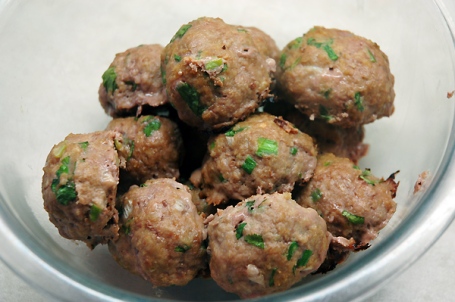 Bake the meatballs for 15 – 18 minutes, or until cooked through. Let them cool for about 5 minutes.
Bake the meatballs for 15 – 18 minutes, or until cooked through. Let them cool for about 5 minutes.
In the meantime, make your sauce. Mix 4 tablespoons soy sauce, 1 teaspoon sesame oil, 2 tablespoons fresh lime juice, 2 tablespoons water, and one diced green onion. Place the meatballs in a serving bowl, and drizzle them with some of the sauce. Save the rest to serve with the meatballs at the table.
recipe adapted from Skinny Taste
Asian Turkey Meatballs with Lime Sesame Sauce
(makes 12 – 14 meatballs)
- 1 lb. ground turkey meat
- 1 Tbsp. ginger paste
- 1 clove minced garlic
- 1 Tbsp. soy sauce
- 2 tsp. sesame oil
- dash of salt
- 1/4 c. chopped cilantro
- 3 green onions, diced
- 1 egg
- 1/4 c. panko bread crumbs
Sesame Lime Sauce:
- 4 Tbsp. soy sauce
- 1 tsp. sesame oil
- 2 Tbsp. fresh lime juice
- 2 Tbsp. water
- 1 green onion, diced
- In a large bowl combine turkey, ginger paste, garlic, soy sauce, sesame oil, salt, cilantro, green onions, egg, and panko. Mix with your hands until well combined.
- Use about 1/4 c. of mixture to make each meatball, rolling the mixture in your hands to form them. Place on a greased baking sheet. Cover and place sheet in refrigerator for 1 hour (optional).
- Pre-heat oven to 450° F.
- Bake meatballs for 15 – 18 minutes, or until cooked through. Let cool for 5 minutes before placing in a serving bowl.
- Mix sauce ingredients in a small bowl. Spoon 1 Tbsp. of the sauce over the meatballs. Serve the rest of the sauce with the meatballs at the table.
Yakiniku – Grilled Meat Japanese Style
Hello all!
Last night, Hisa’s family took Hisa and I out to a yakiniku restaurant (there’s a grill in your table, and you grill meat right at your table and eat it) for dinner. It was fun, and the food was great, but I’ve only been to a yakiniku restaurant in Japan once before that I recall, so I found myself a bit lost when it came to yakiniku etiquette. I managed to discover a few things in the process of dinner last night, however.
1) Yakiniku restaurants will make your clothes, hair, and very skin smell of grilled meat and smoke. I Febrezed my coat last night and hung it up to air out, but I think the smell is still lingering…
2) There’s no niceties with yakiniku. It’s eat or be eaten. Everybody would continually add meat to the grill when some was eaten, and I found myself not really knowing what meat was done cooking, and what meat was still a little raw (beef I’m okay with generally, but under-cooked pork and especially chicken freak me out). As a result, while I was a bit confused and hesitating, much of the meat was eaten up by my husband and sister-in-law. Opps.
3) I’m not a big fan of either cow tongue or cow liver. The was it works is you order whatever cuts of meat you want, and they bring them out on plates (it’s always cut into thin slices), and you grill it at the table. My husband ordered the cow tongue, so I thought I would try it. It looks like regular beef when cooked, but it tastes slightly different and is a bit….chewy. Not bad, but I think I’ll stick to more familiar cuts of beef in the future.

My father-in-law, mother-in-law, and sister-in-law
 Me, Hisa, my adorable niece, and her mom (my sister-in-law). My brother-in-law was still at work and couldn’t come unfortunately.
Me, Hisa, my adorable niece, and her mom (my sister-in-law). My brother-in-law was still at work and couldn’t come unfortunately.
 Adding meat, flipping meat, eating meat. I was a bit lost.
Adding meat, flipping meat, eating meat. I was a bit lost.
Next time (whenever that is), I think I’ll have a better idea of what to do. Or I can just steal all my husband’s meat, haha!
Teriyaki Tofu Burgers
Tofu.
This one word can arouse all sorts of feelings in different people. Delight, hunger, indifference, curiosity, and for some, disgust and revulsion.
I love tofu. I’ve been eating it ever since I was a kid (thanks Dad), so it’s nothing new to me.
Due to its very mild flavor, tofu is rarely ever eaten plain. But because of it’s almost nonexistent flavor, it’s extremely versatile. You can add it to just about anything.
In case you don’t know, tofu is made from soy milk (which is made from soy beans). The soy milk is coagulated so that curds form (much like when you make cheese from milk), and the curds are then pressed into cakes.
It originated in Ancient China (although exactly when and where in China is a bit fuzzy), and then spread to Japan and Korea.
In Japan, tofu is an extremely common food. It’s also very cheap, unlike its American counterpart. I’ve noticed that in the U.S., people usually eat tofu as an alternative to meat. This, however, is not the case in Japan. More often than not, tofu is used together with meat in a dish. It’s also usually added to miso soup, served as a side dish cold with some sort of topping in the summer, etc. But it’s not considered a meat substitute by most.
Enter the tofu burger. Many Americans will automatically consider this a vegetarian alternative to hamburgers made with beef. Tofu burgers (and tofu hamburger steaks) in Japan, however, almost always contain ground chicken. While most Japanese people think of tofu burgers as a healthier alternative to hamburgers, they don’t consider it a vegetarian alternative.
Honestly, unless your a Buddhist monk living in a monastery, Vegetarianism is not common in Japan (compared with the U.S.), and it’s very difficult to find real vegetarian food (even dishes that appear to be vegetarian dishes are often made with fish stock, fish flakes, small amounts of meat/fish, etc.).
My tofu burgers also have ground chicken in them. I think this not only improves the flavor, but it also helps them stay together a lot better. Feel free to leave out the chicken if you want a real vegetarian tofu burger.
Also, I find it’s easier to use two skillets when making these. That way I can cook all the burgers at once (rather than in batches), so it goes much more quickly, and everything is hot when it’s done.
Teriyaki Tofu Burgers
(makes 9 – 10 patties)
- olive oil
- 1 package firm tofu (drained)
- 1/2 lb. ground chicken
- 1/3 onion, diced
- 1/2 carrot, diced
- 2 – 3 cloves garlic, minced
- 1 Tbsp. grated ginger or ginger paste
- 2 tsp. soy sauce
- good dash of salt and pepper
- 1 egg, beaten
- 1 c. bread crumbs
- hamburger buns
for the teriyaki sauce:
- 2 tsp. sugar
- 4 Tbsp. mirin
- 3 Tbsp. soy sauce
- 1 Tbsp. cooking sake
- Heat a little olive oil in a skillet over medium heat. Saute the onion, carrot, and garlic until tender, about 4 -5 minutes. Turn of heat and set aside.
- In a large bowl, combine tofu, chicken, onion mixture, ginger paste, soy sauce, salt and pepper, egg, and bread crumbs. Mix well.
- Using your hands, form tofu mixture into patties, and place on a lined baking sheet. Cover and refrigerate for at least 30 minutes (this will help the patties stay together when you cook them).
- Heat 2 Tbsp. olive oil in a skillet over medium-high heat. Add half the tofu burgers and cook until browned on one side (about 5 – 6 minutes), then flip and cook until browned on the other side (another 5 – 6 minutes). Place burgers on a paper-towel lined plate, and then cook the remaining burgers in the skillet, adding more oil if necessary. After cooking the remaining burgers on both sides, remove burgers to the plate. Use a paper towel to quickly wipe off the excess oil in the skillet (being careful not to burn yourself; use a spatula or wooden spoon to move the paper towel around the skillet if necessary).
- In a small bowl, combine the ingredients for the teriyaki sauce.
- Return skillet to stove over medium heat. Add half the burgers to the skillet. Pour half the teriyaki mixture over the burgers. Bring the sauce to a simmer, and move the burgers around in it. Flip them once so both sides of the burgers are well coated with the sauce. When the sauce is almost completely gone (it will reduce, thicken, and stick to the burgers until there’s almost no sauce left in the skillet), remove the burgers to a serving plate. Repeat with the remaining burgers and the remaining teriyaki sauce.
- Serve with toasted hamburger buns, mayonnaise, and any condiments you want.


